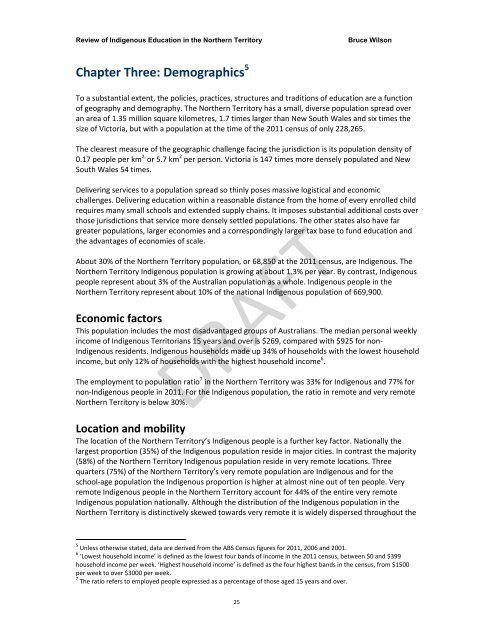Indigenous-Education-Review_DRAFT
Indigenous-Education-Review_DRAFT
Indigenous-Education-Review_DRAFT
Create successful ePaper yourself
Turn your PDF publications into a flip-book with our unique Google optimized e-Paper software.
<strong>Review</strong> of <strong>Indigenous</strong> <strong>Education</strong> in the Northern Territory<br />
Bruce Wilson<br />
Chapter Three: Demographics 5<br />
To a substantial extent, the policies, practices, structures and traditions of education are a function<br />
of geography and demography. The Northern Territory has a small, diverse population spread over<br />
an area of 1.35 million square kilometres, 1.7 times larger than New South Wales and six times the<br />
size of Victoria, but with a population at the time of the 2011 census of only 228,265.<br />
The clearest measure of the geographic challenge facing the jurisdiction is its population density of<br />
0.17 people per km 2, or 5.7 km 2 per person. Victoria is 147 times more densely populated and New<br />
South Wales 54 times.<br />
Delivering services to a population spread so thinly poses massive logistical and economic<br />
challenges. Delivering education within a reasonable distance from the home of every enrolled child<br />
requires many small schools and extended supply chains. It imposes substantial additional costs over<br />
those jurisdictions that service more densely settled populations. The other states also have far<br />
greater populations, larger economies and a correspondingly larger tax base to fund education and<br />
the advantages of economies of scale.<br />
About 30% of the Northern Territory population, or 68,850 at the 2011 census, are <strong>Indigenous</strong>. The<br />
Northern Territory <strong>Indigenous</strong> population is growing at about 1.3% per year. By contrast, <strong>Indigenous</strong><br />
people represent about 3% of the Australian population as a whole. <strong>Indigenous</strong> people in the<br />
Northern Territory represent about 10% of the national <strong>Indigenous</strong> population of 669,900.<br />
Economic factors<br />
This population includes the most disadvantaged groups of Australians. The median personal weekly<br />
income of <strong>Indigenous</strong> Territorians 15 years and over is $269, compared with $925 for non‐<br />
<strong>Indigenous</strong> residents. <strong>Indigenous</strong> households made up 34% of households with the lowest household<br />
income, but only 12% of households with the highest household income 6 .<br />
<strong>DRAFT</strong><br />
The employment to population ratio 7 in the Northern Territory was 33% for <strong>Indigenous</strong> and 77% for<br />
non‐<strong>Indigenous</strong> people in 2011. For the <strong>Indigenous</strong> population, the ratio in remote and very remote<br />
Northern Territory is below 30%.<br />
Location and mobility<br />
The location of the Northern Territory’s <strong>Indigenous</strong> people is a further key factor. Nationally the<br />
largest proportion (35%) of the <strong>Indigenous</strong> population reside in major cities. In contrast the majority<br />
(58%) of the Northern Territory <strong>Indigenous</strong> population reside in very remote locations. Three<br />
quarters (75%) of the Northern Territory’s very remote population are <strong>Indigenous</strong> and for the<br />
school‐age population the <strong>Indigenous</strong> proportion is higher at almost nine out of ten people. Very<br />
remote <strong>Indigenous</strong> people in the Northern Territory account for 44% of the entire very remote<br />
<strong>Indigenous</strong> population nationally. Although the distribution of the <strong>Indigenous</strong> population in the<br />
Northern Territory is distinctively skewed towards very remote it is widely dispersed throughout the<br />
5 Unless otherwise stated, data are derived from the ABS Census figures for 2011, 2006 and 2001.<br />
6 ‘Lowest household income’ is defined as the lowest four bands of income in the 2011 census, between $0 and $399<br />
household income per week. ‘Highest household income’ is defined as the four highest bands in the census, from $1500<br />
per week to over $3000 per week.<br />
7 The ratio refers to employed people expressed as a percentage of those aged 15 years and over.<br />
25


